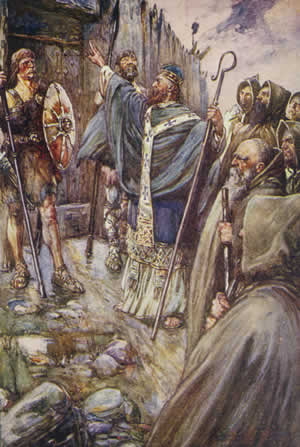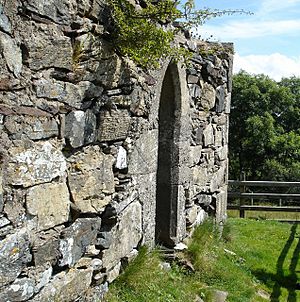Columba facts for kids
Quick facts for kids SaintColumba |
|
|---|---|

Saint Columba, Apostle to the Picts
|
|
| Apostle of the Picts | |
| Born | 7 December 521 AD Gartan, Tyrconnell, Gaelic Ireland |
| Died | 9 June 597 AD (aged 75) Iona, Dál Riata |
| Venerated in | Catholic Church Eastern Orthodox Church Anglican Communion Presbyterian Church |
| Major shrine | Iona, Scotland |
| Feast | 9 June |
| Attributes | Monk's robes, Celtic tonsure and crosier. |
| Patronage | Derry, floods, bookbinders, poets, Ireland, and Scotland. |
Columba (also known as Colmcille) was an Irish abbot and missionary who helped spread Christianity in what is now Scotland. He was born on December 7, 521 AD, and died on June 9, 597 AD. He founded a very important abbey (a type of monastery) on the island of Iona. This abbey became a powerful religious and political center for many years.
Columba is the patron saint of Derry in Ireland. Both the Gaels (people from Ireland and Scotland) and the Picts (ancient people of Scotland) respected him greatly. Today, he is remembered as a Catholic saint and one of the Twelve Apostles of Ireland.
Columba studied with important church leaders in Ireland and started several monasteries there. Around 563 AD, he and twelve friends sailed to Scotland. They settled on Iona, which was then part of the Dál Riata kingdom. There, they built a new abbey. This abbey was a base for sharing Celtic Christianity with the pagan (non-Christian) Northern Pictish kingdoms. Even though he spent most of his later life in Scotland, he remained involved in Irish affairs.
Contents
Columba's Early Life in Ireland
Columba was born in Gartan, a place near Lough Gartan in County Donegal, Ireland. His parents were Fedlimid and Eithne. His family was said to be related to Niall of the Nine Hostages, a famous Irish high king from the 5th century. His teacher and foster-uncle, Cruithnechán, baptized him in Temple-Douglas.
Columba lived for about five years in a small village called Glencolmcille, which was named after him. It's not certain if his birth name was Colmcille or if he chose it later. Some say his birth name was Crimthann, meaning 'fox'. In Irish, his name means 'dove', just like the Prophet Jonah. The Latin word for dove is also Columba.

When he was old enough, Columba went to the monastic school of Movilla. This school was led by Finnian of Movilla. After finishing his training there, he traveled south to Leinster. He then became a student at Clonard Abbey, which was known for its holiness and learning. Here, he learned about the traditions of the Welsh Church.
In early Christian Ireland, monasteries became important centers for learning. People studied Latin and Christian theology. Clonard Abbey was a very famous monastery. It was said to have 300 students at one time. Columba was one of twelve students of Finnian of Clonard who became known as the Twelve Apostles of Ireland. He became a monk and later was ordained as a priest.
Another teacher of Columba was Mobhí Clárainech. His monastery at Glasnevin was visited by famous people like Cainnech of Aghaboe and Ciarán. In 544, a serious illness spread across Ireland, causing Mobhi's students to scatter. Columba returned to his home area in Ulster. He was a tall, strong man with a loud, clear voice that could be heard from far away.
In the years that followed, Columba founded several important monasteries. These included Derry, Durrow, Kells, and Swords. While at Derry, he reportedly planned a trip to Rome and Jerusalem. However, he only went as far as Tours in France. From Tours, he brought back a copy of the gospels that had been with St Martin for 100 years. This special book was kept in Derry.
Some stories say that around 560, Columba had a disagreement with Finnian of Moville over a psalter (a book of psalms). Columba copied the book, but Finnian believed he had no right to keep the copy. This conflict might have led to the Battle of Cúl Dreimhne in 561, where many people died. However, historians debate if this battle was directly caused by the book. It seems more likely that political conflicts were already happening. For example, King Diarmait had broken the rule of sanctuary by killing Prince Curnan, Columba's relative, who had sought protection with Columba.
A group of clerics and scholars considered excommunicating Columba for the deaths. But Brendan of Birr spoke up for him, and the process was stopped. Columba felt bad about what happened. An old hermit named Molaise advised him to leave Ireland to make up for the trouble. Some call this an "exile," but others call it a "pilgrimage." A marker at Stroove Beach shows where Columba sailed from Ireland to Scotland. He left Ireland but returned several times over the years to visit the communities he had founded.
Columba's copy of the psalter is traditionally linked to the Cathach of St. Columba. In 574 or 575, when he returned for a meeting called the Synod of Drum Ceat, he founded the monastery of Drumcliff in County Sligo, near the battlefield.
Columba's Work in Scotland
In 563, Columba traveled to Scotland with twelve companions. They sailed in a currach, a boat made of wicker covered with leather. Legend says he first landed on the Kintyre Peninsula. But because he could still see Ireland, he moved further north. His relative, Conall mac Comgaill, who was King of Dál Riata, gave him the island of Iona. King Conall might have even invited Columba to Scotland. Columba was not really leaving his own people, as Irish Gaels had been settling the west coast of Scotland for a long time.
Columba was the only person in the area who could read and write well. His reputation as a holy man also made him a good diplomat between different tribes. Many stories tell of miracles he performed while converting the Picts to Christianity. The most famous story is his encounter with a "water beast" in the River Ness in 565. Some people think this was the Loch Ness Monster. The story says he banished the beast after it attacked one of his followers.
Columba visited the pagan King Bridei at his home in Inverness. He earned Bridei's respect, even though Bridei did not convert to Christianity. Columba then played a big part in the politics of the country.
He was also a very active missionary. He founded several churches in the Hebrides islands. He also turned his monastery at Iona into a school for missionaries. Columba was known as a man of letters. He wrote several hymns and is believed to have copied 300 books. One of the few times he left Scotland was near the end of his life. He returned to Ireland to found the monastery at Durrow.
According to old stories, Columba died on Iona on Sunday, June 9, 597. He was buried by his monks in the abbey he had built. However, some historians suggest he might have died in 593. The records show that Iona was raided by Vikings in 795, 802, 806, and 825. Columba's remains were finally moved in 849 and divided between Scotland and Ireland.
Columba's Lasting Legacy
In Ireland
In Ireland, Saint Columba is usually called Colmcille. He is one of the three patron saints of Ireland, along with Patrick and Brigid of Kildare.
Colmcille is the patron saint of Derry. He founded a monastery there around 540 AD. The city's name in Irish is Doire Cholm Cille. This name comes from the oak trees in the area and the city's connection to Colmcille. Many churches and schools in Derry are named after him, including St Columb's Cathedral and St Columb's College.
Other schools in Ireland, like St. Columba's National School in Drumcondra and St. Colmcille's schools in Knocklyon, Dublin, are also named after him. The town of Swords, Dublin was supposedly founded by Colmcille in 560 AD, and schools and a local sports team there bear his name.
The Columba Press, a company that publishes religious books in Dublin, is named after Colmcille. Even Aer Lingus, Ireland's national airline, has named one of its planes after the saint.
In Scotland
Columba is seen as a key figure in bringing back and strengthening monasticism (monk life) in Scotland. Some Scottish clans, like the Clan Malcolm/Clan McCallum and Clan Robertson, claim to be descended from his followers. The Clan MacKinnon also has a strong link, as MacKinnons were abbots of Iona for centuries after Columba founded his monastery.
Many Catholic churches, schools, and parishes in Scotland are dedicated to Saint Columba. Other churches, like the Scottish Episcopal Church and the Church of Scotland, also have parishes named after him. The village of Kilmacolm in Renfrewshire gets its name from Colmcille.
St Columba's Hospice, a well-known hospice in Edinburgh, is also named after the saint.
His Poetry
Two poems are believed to have been written by Columba: "Adiutor Laborantium" and "Altus Prosator". Both are Abecedarian hymns in Latin. This means their lines or stanzas start with letters in alphabetical order. He wrote them while at the Iona Abbey.
"Adiutor Laborantium" is a shorter poem. It has 27 lines, each with eight syllables. The poem talks about God as a helper, protector, and guide for good people, and someone who will punish sinners.
"Altus Prosator" is a longer poem with 23 stanzas. Each stanza starts with a different letter of the alphabet. The poem tells a story in three parts: the beginning of time, the creation of the world, and the end of time (the Apocalypse).
Other Connections
In Canada, many people have Scottish roots. Because of this, Columba's name is found on many Catholic, Anglican, and Presbyterian churches, especially in eastern Canada.
Across the United States, many Catholic and Episcopalian churches are dedicated to Columba. The Presbyterian Church, which has Scottish roots, also has churches named after him. Columba is the patron saint of the Roman Catholic Diocese of Youngstown, Ohio, and its cathedral is named for him.
Iona University in New York, a Catholic college, is named after the island where Columba built his first monastery in Scotland. Other colleges in Canada and Australia are also named Iona.
There are at least four pipe bands named after him, located in Ireland, Northern Ireland, and the United States. St. Columba's School in India, run by the Irish Christian Brothers, is also named after the saint. The Munich GAA team is called München Colmcilles.
Saint Columba's Feast Day, June 9, is now International Celtic Art Day. Famous medieval artworks like the Book of Kells and the Book of Durrow are linked to Columba.
The composer Benjamin Britten wrote "A Hymn of St Columba" in 1962. He set a poem by the saint to music for a choir and organ. This was to celebrate 1,400 years since Columba's journey to Iona.
Columba is also honored in the Anglican Church, including the Church of England and the Episcopal Church in the US, on June 9.
|
See also
 In Spanish: Columba de Iona para niños
In Spanish: Columba de Iona para niños
- Catholic Church in Ireland
- Catholic Church in Scotland
- Celtic Christianity
- Columba College
- Early Christian Ireland
- List of people on stamps of Ireland
- List of saints
- Old High St Stephen's, Inverness
- St Columb's College
- St. Columba's School (disambiguation)
- Sainte-Colombe
- Saint Columba, patron saint archive
- Scoil Colmcille
- Scotland in the Early Middle Ages

